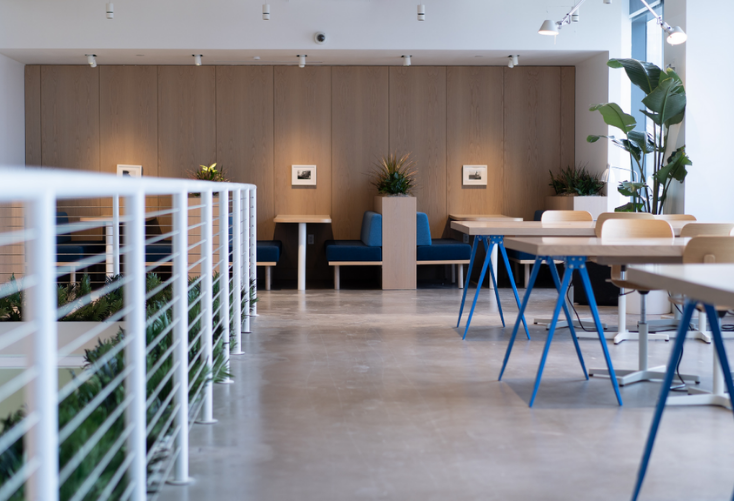Hand selected flexible workspace news from the most reliable sources to keep you ahead of the pack. We find all the latest news, so you don’t have to. Morning and afternoon updates. Stay in the know.
Here’s what you need to know today:
- Coworking Will Continue Growing Through 2025
- What The The Future Of Work Holds
- Demand For Flex Offices Is Growing In Secondary Cities
- The Dangers Of IoT Devices In Offices
- The Revitalized Purpose Of The Office
- The Benefits The Best Workplaces Offer Employees
Coworking Will Continue Growing Through 2025
Research from digital coaching provider Ezra is anticipating that by 2025, 6.3 million of workers will be using a shared office space and that America will lead this transformation.
Last year alone, the number of coworking spaces grew by 21%, which is a 42% increase from 2018. Demand has simultaneously grown, with the number of coworking space users growing by 27% since 2020.
Although the pandemic has forced many of these offices to temporarily or indefinitely shut down, Ezra’s research indicates the anticipated annual growth of 21.3% is keeping coworking prominent.
At the moment, America is the top country for coworking spaces with an estimated 3,762 spaces.
“Coworking spaces have become incredibly popular in recent years as they not only provide flexibility and affordability, but also a fresh business culture focussed on accessibility and collaboration,” said Nick Goldberg, founder of Ezra. “Of course, the pandemic will have caused many to swap their shared workspace for a home office for the short term, but this popularity is expected to keep growing as the world reopens and the way we work continues to evolve.”

What The The Future Of Work Holds
The long-term impact of the pandemic is unknown. While it is impossible to fully predict what society will look like, there have been numerous predictions and research conducted about the future of the workplace.
For starters, the world’s largest work from home experiment has led more professionals to desire flexibility in the future. In fact, research from Slack found that 72% of workers want a mixture of in-person and remote working arrangements.
CFOs have also reevaluated the need for real estate as it has not yielded much value in recent months. CBRE estimated that there was 4 billion square feet of vacant office space across the 54 largest markets in the U.S. over the past year.
However, the lack of human connection from new remote working positions has taken a mental toll on many workers and issues of depression, anxiety and isolation have hindered work quality.
All of these revelations somewhat contradict each other. The only true clear answer is that there is no clear answer. But even ambiguity requires flexibility, so companies will need to stay on their toes in order to accommodate the best work environment for their employees.
Receiving feedback from employees will be essential in the post-pandemic workplace. There is no one-size-fits-all approach, so understanding what each employee needs will help businesses support their workers while optimizing their productivity.

Demand For Flex Offices Is Growing In Secondary Cities
The Instant Group’s U.S. Market Summary has found that the cost-per-desk for flexible workspaces is following two paths: prices are declining in gateway cities and increasing in secondary markets.
For example, the cost-per-desk in New York City’s Midtown Market declined by 29%, followed by Washington D.C.’s costs falling by 23% and Boston’s costs falling by 22%.
However, Phoenix’s cost-per-desk saw an increase of 39%, followed by a 14% increase in Nashville, and 11% in Denver.
The report highlights the fact that flexible workspaces are moving away from central cities and into smaller areas, such as the suburbs, where people live. In fact, demand for flexible office space fell by 14% in New York City last year, but rose in areas like Westchester, New York and Connecticut.
Although this is good news for these secondary cities and suburbs, The Instant Group notes that the challenge will be whether these operators can meet demand and offer the same level of service that major city options provide.
Still, the cost advantages to both tenants and operators means that demand in these areas is expected to continue growing.

The Dangers Of IoT Devices In Offices
Security risks have spiked simultaneously with the increased use of the Internet of Things. The incorporation of smart sensors and other technologies within buildings have become more popular in recent years, but these systems and tools come with their fair share of challenges.
Cybercriminals are often able to take advantage of vulnerabilities in certain technologies, even ones that may not be considered a threat. For example, President Joe Biden was told not to bring his smart bike into the White House in January due to security risks.
Prior to the mass adoption of IoT, buildings used self-contained systems that were safe from hackers. Now that remote management has become a mainstay, the threat of hacking has become real.
“Poorly configured building management systems, which handle aspects such as access control and air conditioning, or even a landlord’s network infrastructure can provide a gateway to a remote attacker,” said Nick Morgan, information security manager at property investor Derwent London.
It’s clear that companies need to ramp up security measures since all IoT devices offer an entry point for hackers, according to William Newton, president of WiredScore.
Now is the time to invest into security testing, monitoring and new strategies, instead of waiting for an actual data breach to occur.

The Revitalized Purpose Of The Office
Workers have realized that they are just as productive, if not more, when working remotely. However, some business leaders are still wary of the idea despite the past year disproving misconceptions about this work arrangement.
Still, the return to the office is inevitable for many. But instead of asking when employees will return, it’s time to start asking why.
There is a revitalized purpose of the office. Instead of featuring a sea of desks for every employee five days each week, it will focus more on collaborative spaces that nurture teamwork.
When employees come into the office, it will likely be to have access to certain tools they do not have at home and have face-to-face interactions with their colleagues.
“We’ve seen clients put out surveys to staff asking if they will return to the office and if so, how often,” said Aimee Collins, principal of design for global workspace delivery firm Unispace. “The drivers for people wanting to come back to work are seamless and intuitive spaces for collaboration and camaraderie.”
Unispace in particular has taken note of these changes and has created an agile workspace framework called Propeller.
This model aims to merge the perks of working from home as well as the benefits of in-office environments. By using internal and external data, Unispace helps companies reconfigure their workspaces by adjusting their goals and uniquely tailor solutions to accommodate their needs.

The Benefits The Best Workplaces Offer Employees
Inc.’s annual Best Workplaces survey found that benefits that focus on wellness outweigh fun, lightweight perks such as free coffee and happy hours.
The survey of 422,000 employees across 3,000 companies in North America revealed that the pandemic has taken a huge toll on the mental health of employees. Of the companies that were named Inc.’s Best Workplace, 70% of them offered access to mental health resources, counselors and other employee assistance programs.
The majority of the 429 Best Workplaces also offered flexible working hours, with many making this policy a priority in the past year. Getting rid of the traditional 9 to 5 model has been found to offer more freedom for employees and aid in their work-life balance.
Many companies among the top workplaces also enhanced their pet policies in the past year. For instance, investment management software provider Ridgeline has started offering employees two days of paid time off if they adopt a pet.
Retirement plans have long been a necessary benefit for many employees, but the past year has accelerated the need to improve these programs, with 97% of companies on the list now offering 401(k), Simple IRA or other retirement options.
Additionally, 58% of this year’s Best Workplace stated that they offer unlimited paid time off to employees. Even some companies reserve one day each month to be served as a company holiday or mental health day such as San Francisco-based software firm Sift.



 Dr. Gleb Tsipursky – The Office Whisperer
Dr. Gleb Tsipursky – The Office Whisperer Nirit Cohen – WorkFutures
Nirit Cohen – WorkFutures Angela Howard – Culture Expert
Angela Howard – Culture Expert Drew Jones – Design & Innovation
Drew Jones – Design & Innovation Jonathan Price – CRE & Flex Expert
Jonathan Price – CRE & Flex Expert












